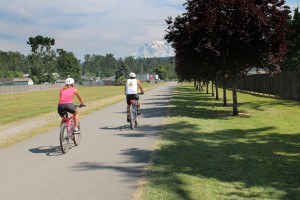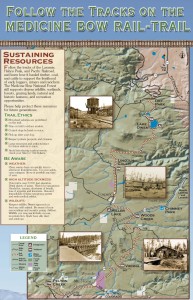See update, March 10, 2014 — “Supreme Court ruling deals uncertain future for rails-to-trails program.”
A Wyoming landowner’s challenge to a law that helps establish rail-trails for bicyclists and others on abandoned railroad right-of-ways could add a layer of uncertainty to development of rails to trails in the future.
There could be implications in Washington state, where the Foothills and the John Wayne Pioneer trails among others were built on corridors originally granted to the railroads by the federal government.
The case Marvin M. Brandt Revocable Trust vs. the United States was argued in front of the US Supreme Court on Tuesday.
The landowner, represented by the conservative Mountain States Legal Foundation, asserts that an abandoned Northern Pacific Railroad right-of-way through his property in southeastern Wyoming should revert to him and not the public.
The U.S. government, and groups such as the Rails-to-Trails Conservancy, argue that a series of laws dating back to 1875 intend for those abandoned railroad corridors to remain in public use.
Over the years, those laws have resulted in the creation of 1,827 rail-trails across the nation, covering 21,648 miles. In addition, another 7,836 miles of abandoned railway are projected to be included in 681 rail-trail projects that are in the pipeline. Millions of bicyclists use those trails for touring, daily recreation and commuting to work. Hikers and equestrians also use those trails.
Adding a “layer of uncertainty”
At issue is the continuation of the 21-mile Medicine Bow Rail Trail that was completed in southeastern Wyoming in 2007. But a Supreme Court ruling in favor of the landowner could set a nationwide precedent.
The Rails to Trails Conservancy says a loss could threaten development of rail-trails across the U.S. that use federally granted rights-of-way. Examples of such rail-trails include the George S. Mickelson Trail in South Dakota, the Foothills Trail and the John Wayne Pioneer trails in Washington state, the Weiser River Trail in Idaho and the Rio Grande Trail in Colorado.
Jake Lynch of Rails to Trails Conservancy said that a Supreme Court ruling that “throws into question the authority of the United States to develop public uses like rail-trails on these federally-granted rights-of-way would certainly add a layer of uncertainty to proposals to develop trails in the future.
“What it will mean for existing trails that utilize federally-granted rights-of-way is less clear. We suspect the most immediate impact will be a rush of litigation by adjoining property owners against the United States. A reinterpretation of the law concerning federally-granted rights-of-way wouldn’t “ban” rail-trails, but it would possibly mean the United States would be liable to compensate to landowners.
“We don’t believe that the American people should have to pay millions of dollars to a landowner every time it wants to provide public access across a corridor of public land which was secured in the first place for exactly the purpose of providing public access.”
In recent years, property owner challenges in south King County and Pierce counties has delayed sections of the Foothills Rail-Trail.
The trail currently runs for about 15 miles from a trailhead near Puyallup, through Orting, to its terminus at South Prairie. Other pieces of the trail exist between South Prairie and Enumclaw to the north and Wilkeson to the south, although connections on abandoned railroad corridors have been delayed because of disputes with private property owners.
Railroad laws
The crux of the disagreement between the Brandts and the government dates back to the 1875 General Railroad Right-of-Way Act. Congress granted railroad companies a 100-foot-wide right-of-way on public land in the law, with the stipulation that the right-of-way revert back to public use if the railroads stopped using them.
Rails to Trails Conservancy explains, “Not only did this ensure that the corridors would remain available for public use, but it also ensured these vital transportation routes would remain in place should rail service become viable or necessary once again.”
Sometimes those abandoned railroad corridors are used for public rail-trails, but they’ve also been used for roads. Plans for the abandoned Burlington Northern line in Seattle’s eastern suburbans call for passenger rail and trails running side by side.
The 80-acre parcel in question in southeastern Wyoming has been private property since the 1970s, and the Brandts sued to block the 10-acre abandoned railroad corridor from returning to public ownership and use as part of the Medicine Bow Rail Trail.
Supreme Court
Lyle Denniston, reporter at the SCOTUS blog, attended the Supreme Court arguments on Tuesday. He wrote that it wasn’t clear what would guide the justices in making a decision in the case.
In reading the transcript of the oral arguments, a lot of the talk dealt with the complications of property law. In other cases, some comments sounded ridiculous.
In one discussion, the justices were trying to find out how many property the federal government claimed to control throughout the West in railroad right of way.
Consider this from Justice Stephen Breyer:
“Well, I see that they do and I certainly think bicycle paths are a good idea, but the problem that I see here is just what Justice Kagan is bringing up; that is, as I read this, I think there might be millions of acres in the last 70 years that have been conveyed. For all I know, there is some right of way that goes through people’s houses, you know, and all of a sudden, they are going to be living in their house and suddenly a bicycle will run through it, which isn’t so bad, but I’m concerned about that, and your answer makes me more concerned…”
The Justice Department lawyer, Anthony A. Yang, said he didn’t know how much property was as stake and didn’t think that figure was available.
SCOTUS blog reported that the Mountain States Legal Foundation attorney representing the Brandts, Steven J. Lechner, seemed to have the support of conservative justice Antonin Scalia during the questioning.
The case ended up in the Supreme Court after the US District Court for the District of Wyoming and the US 10th Circuit Court of Appeals both ruled in favor of the government controlling the abandoned railroad land. No timetable for a decision.
For more on this issue:
SCOTUS blog information page on the case (also filings, transcripts and reporting)
Rails to Trails Conservancy information on the case
FAQ about the case, Rails to Trails Conservancy
Medicine Bow Rail-Trail (Google locater map)
Discussion of case issues, DC.StreetsBlog.org



3 pings
[…] US Supreme Court battle threatens rail-trails » Biking Bis […]
[…] in landowner disputes. The future of those trails might be decided in the US Supreme Court in the Marvin M. Brandt Revocable Trust vs. the United States case involving a private landholder in […]
[…] staff also does a lot of advocacy work in the nation’s capital. RTC recently filed a legal brief on behalf of the US Justice Department in the US Supreme Court case Marvin M. Brandt Revocable […]